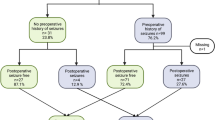Summary
In this study of 34 consecutive histologically confirmed oligodendroglial brain tumours (15 oligoastrocytoma, 12 oligodendroglioma, 7 anaplastic oligodendroglioma) twenty five patients (75%) presented with symptoms related to seizures. Although the seizure incidence was lowest in anaplastic oligodendroglioma (57%) it was not statistically different from either pure (75%) or mixed (80%) oligodendroglial tumours. Patients with seizures had a significantly lower age (p < 0.001) at diagnosis (median 36 years) than those without seizures (57 years). The types of seizure disorder, that were present for a median of 15 months prior to surgery, were variable with 32% having generalised, 36% partial and 32% mixed patterns. There were no significant differences between either the type or incidence of seizures and the particular cerebral location of the oligodendroglial tumour.
Twenty four of the patients presenting with seizures underwent surgery (5 stereotactic biopsy, 5 stereotactic guided resection and 14 conventional craniotomy and resection) without intraoperative electrocorticography (ECoG). Eighteen (75%) of these patients also had postoperative radiotherapy (40 to 54 Gy in 30 fractions.
Following these treatments the percentage of patients fit free at 6, 12, and 24 months were 67%, 56%, and 53%, respectively. Median time to first post operative seizure was 32 weeks (range 5 weeks to 5.3 years). After a median follow up time of 30 months 20 of the 25 patients who presented with seizures were still alive. Eight (40%) were seizure free and three other patients (15%) had experienced less than three postoperative seizures in follow-up periods ranging from 42 to 62 months. Although the numbers of patients on preoperative (87%) and postoperative (83%) anticonvulsant medications were similar, some had their medications either withdrawn (17%) or reduced (4%) whilst others had it introduced (12%) after interventional management. Only five (20%) patients who presented with seizures, compared to 6 (67%) who had not presented with seizures had died during median follow-up of 28 months. Three of nine patients (33%), who were initially seizure free, developed seizures between 25 and 36 months after initial sugery and radiotherapy.
This study (i) confirms the high incidence of epilepsy in supratentorial oligodendroglial tumours; (ii) has shown that seizures associated with these tumours are significantly more common in younger patients; (iii) suggests that younger age, but not the presence of seizures, is a significant independent prognostic variable; (iv) that seizure control following a second operation is generally disapponting and (v) suggests that tumour resection and radiotherapy often facilitate control of the seizures by anticonvulsants.
Because of the multiple clinicopathological and management variables involved a prospective study would be required to assess the optimal management of patients with seizure disorders associated with oligodendroglial brain tumours.
Similar content being viewed by others
References
Awad IA, Rosenfeld J, Ahl J,et al (1991) Intractable epilepsy gies, and seizure outcome. Epilepsia 32: 179–186
Berger MS, Ghatan S, Haglund MM,et al (1993) Low grade gliomas associated with intractable epilepsy: seizure outcome utilizing electrocorticography during tumour resection. J Neurosurg 79: 62–69
Cairncross JG, MacDonald DR, Ramsay DA (1992) Aggressive oligodendroglioma: a chemosensitive tumour. Neurosurgery 31: 78–82
Cascino G (1990) Epilepsy and brain tumours: implications for treatment. Epilepsia 31 [Suppl 3]: S37-S44
Cascino GD, Boon PAJM, Fish DR (1993) Surgically remediable lesionsal syndromes. In: Engel J Jr (ed) Surgical treatment of the epilepsis, 2nd Ed. Raven, New York, pp 77–86
Chin HW, Haxel JJ, Kim TH,et al (1980) Oligodendrogliomas, 1. A clinical study of cerebral oligodendroglioma. Cancer 45: 1458–1466
Goldring S, Rich KM, Picker S (1985) Experience with gliomas in patients presenting with a chronic seizure disorder. Clin Neurosurg 33: 15–42
Hirsch J-F, Rose CS, Pierre-Kahn A,et al (1989) Benign astrocytic and oligodendrocytic tumours of the cerebral hemispheres in children. J Neurosurg 70: 568–572
Horrax G, Wu WQ (1951) Postoperative survival of patients with intracranial oligodendroglioma with special reference to radical tumour removal. J Neurosurg 8: 473–479
Kirkpatrick P, Honavar M, Janota I,et al (1993) Control of temporal lobe epilepsy following en bloc resection of low grade tumours. J Neurosurg 78: 19–25
Lindegaard K-F, Mork SJ, Eide GE,et al (1987) Statistical analysis of clinicopathological features, radiotherapy, and survival in 170 cases of oligodendroglioma. J Neurosurg 67: 224–230
Penfield W, Erickson TC, Tarlov I (1940) Relation of intracranial tumours and symptomatic epilepsy. Arch Neurol Psychiatry 44: 300–315
Pilcher WH, Silbergelb DC, Berger MS,et al (1993) Intraoperative electrocorticography during tumour resection: impact on seizure outcome in patients with ganglioglioma. J Neurosurg 78: 891–902
Russell D, Rubenstein LJ (1989) The pathology of tumours of the nervous system, 5th Ed. Edward Arnold, London
Shaw EG, Scheithauer BW, O'Fallon JR,etal (1992) Oligodendrogliomas: the Mayo Clinic experience. J Neurosurg 76: 428–434
Smith DE, Hutton JL, Sandemann D,et al (1991) The prognosis of primary intracerebral tumours presenting with epilepsy: the outcome of medical and surgical management. J Neurol Neurosurg Psychiatry 54: 915–920
Wallner KE, Gonzales M, Sheline G (1988) Treatment of oligodendrogliomas with or without postoperative irradiation. J Neurosurg 68: 684–688
Weir B, Elvidge AR (1968) Oligodendrogliomas: an analysis of 63 cases. J Neurosurg 29: 500–505
Whittle IR (1992) Origins and treatment of peritumoural brain dysfunction. Neurosurg Quart 2: 174–199
Whittle IR, Clarke M, Cull RE (1994) Intraoperative electrocorticographic findings during brain tumour resection. Br J Neurosurg: 8: 263–264
MRC Brain Tumour Working Party Report (1990) Prognostic factors for high grade malignant glioma: development of a prognostic index. J Neurooncol 9: 47–55
Author information
Authors and Affiliations
Rights and permissions
About this article
Cite this article
Whittle, I.R., Beaumont, A. Seizures in patients with supratentorial oligodendroglial tumours. Acta neurochir 135, 19–24 (1995). https://doi.org/10.1007/BF02307409
Issue Date:
DOI: https://doi.org/10.1007/BF02307409




